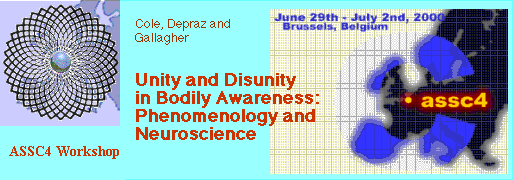
Home -
1 -
2 -
3 -
4 -
5 -
6 -
7 -
8 -
9 -
10 -
11 -
12 -
13 -
14- Bibliography
5. Perception and Proprioception
Text: Gallagher. 2000. Non-perceptual awareness of one's body
Proprioception has a structural (ecological) role to play in perception. Is proprioception itself a form of perception? This depends on how one defines perception.
(a) Object Perception (Shoemaker, 1994, 1986)
Object Constraint: Perception is always perception of an object.
Identification Constraint (see Bermúdez, 1998): Perception involves identification of an object -- being able to pick an object out of a group of other objects, and keeping track of it.
Phenomenological formulation: Perception OF something AS something.
(b) Egocentric Spatial Framework:Perceptual modalities that involve spatial discriminations are structured by a spatial framework that is centered on the embodied subject (Evans, 1982).
Merleau-Ponty (1945): "the body is the subject's point of view on the world. One's own location, which determines what one can perceive, is the location of one's body, and perceived objects are perceived as standing in spatial relations to one's body" (p. 333).
Proprioception can act in a perceptual way: proprioception as reflective awareness -- we can situate the body in an egocentric perspective.
Proprioception, in its typical form (as pre-reflective), a form of non-perceptual awareness.
No object (Cassam, 1995)
No identification or tracking
Intra-bodily spatial framework
Logic: If perception of the world is spatially organized by an implicit reference to our bodily position, the implicit reference itself (proprioception) cannot be based on perceptual awareness without the threat of infinite regress.
Phenomenology: Intracorporeal distance and direction are proprioceptively non-perspectival.
In contrast to perceived objects (one is closer to me than another), my foot is not closer to me than some other body part.
Left, right, center, and distance are spatial parameters that are completely relative in perceptual experience. What is to my right may be to your left. And what is to my right now will be to my left if I turn 180 degrees. But intrabodily parameters are absolute in proprioception. What is proprioceptively on the right side of my body is just so, whether my right side is located to your left, or whether I turn. If I move my left hand to touch my right shoulder, it does not become a second right hand. If sensation A is just this distance from sensation B, I cannot make them closer on the proprioceptive map even if I contort my body to make them objectively closer.
Home -
1 -
2 -
3 -
4 -
5 -
6 -
7 -
8 -
9 -
10 -
11 -
12 -
13 -
14- Bibliography

